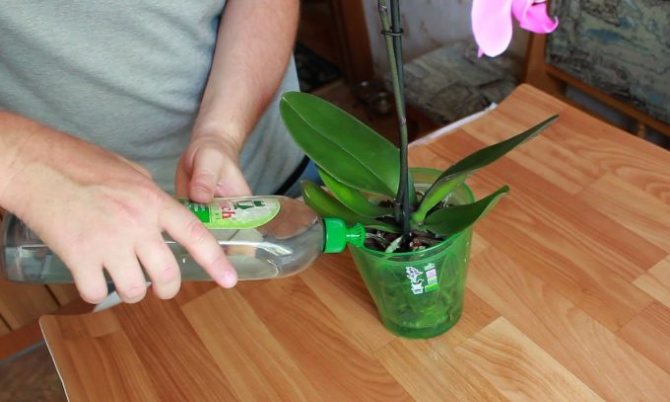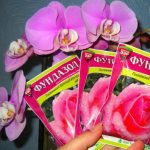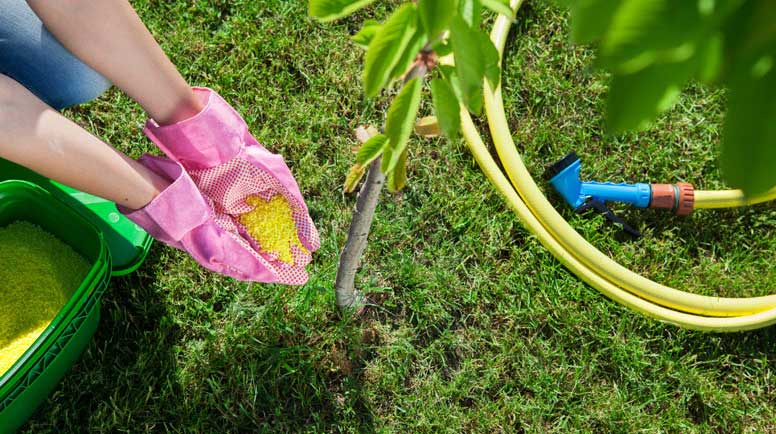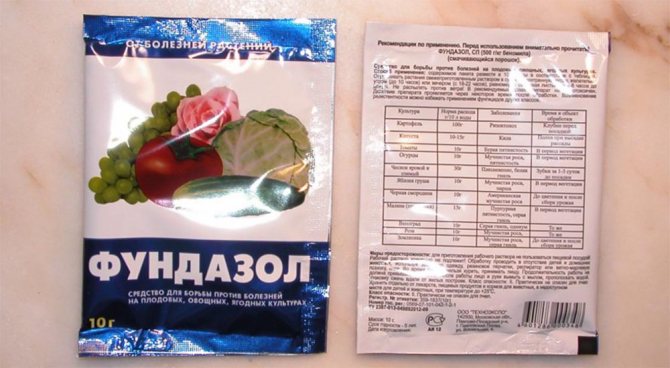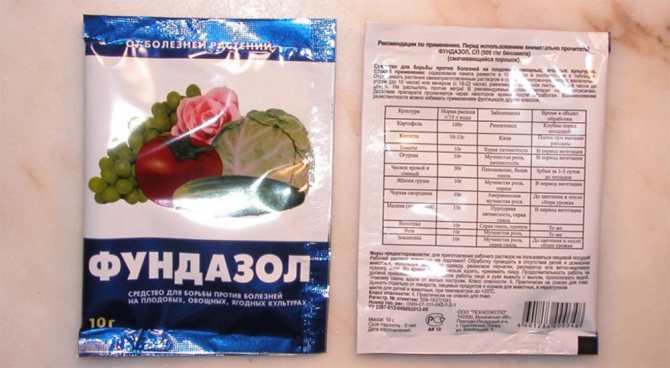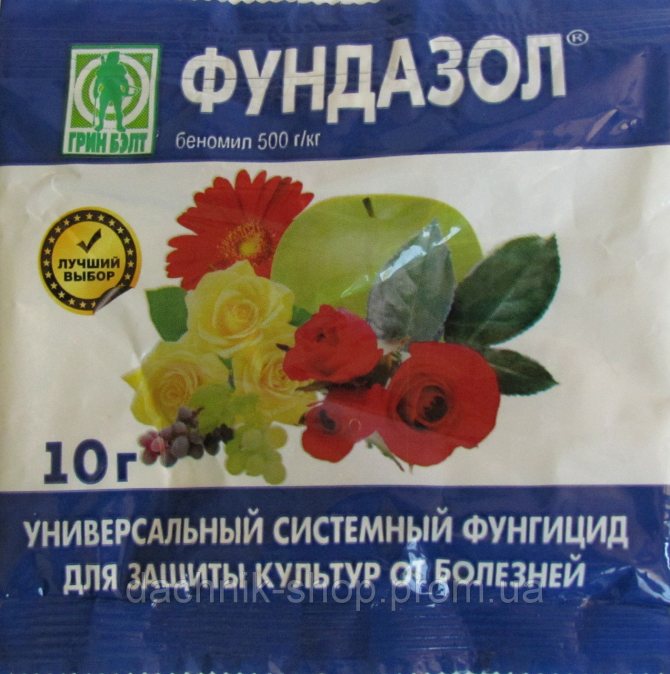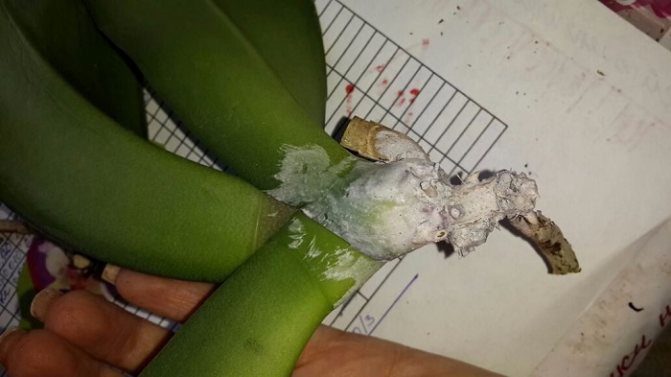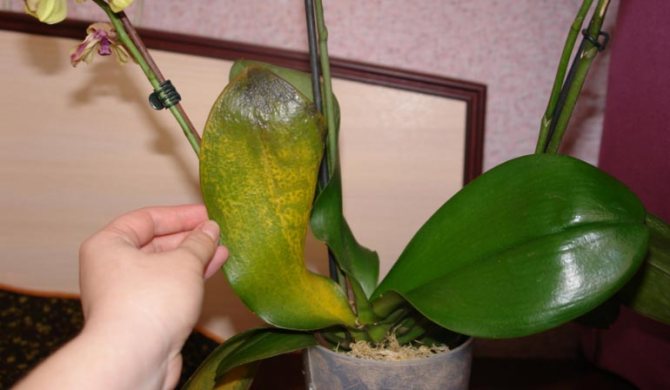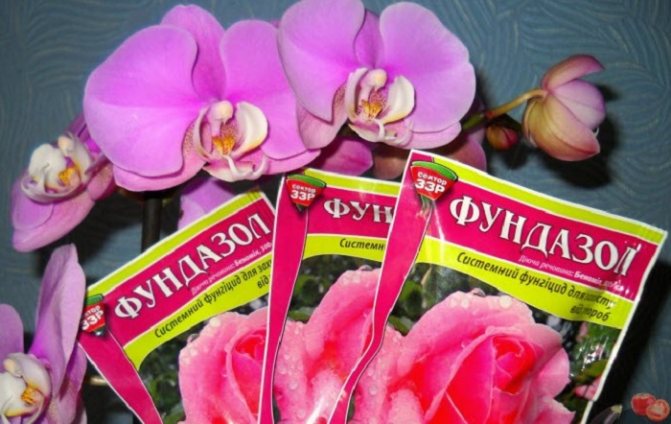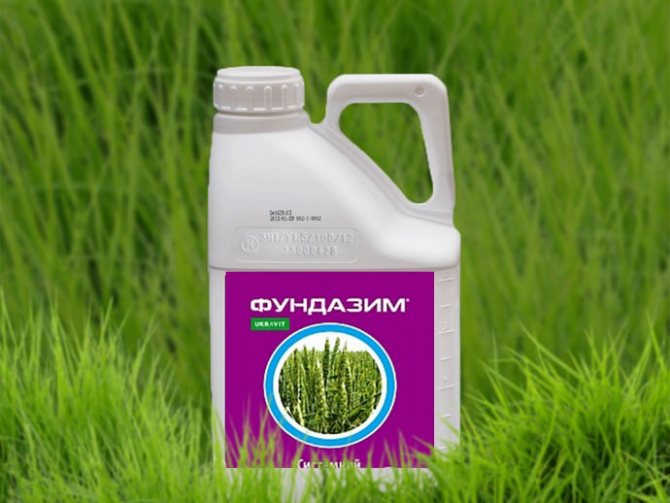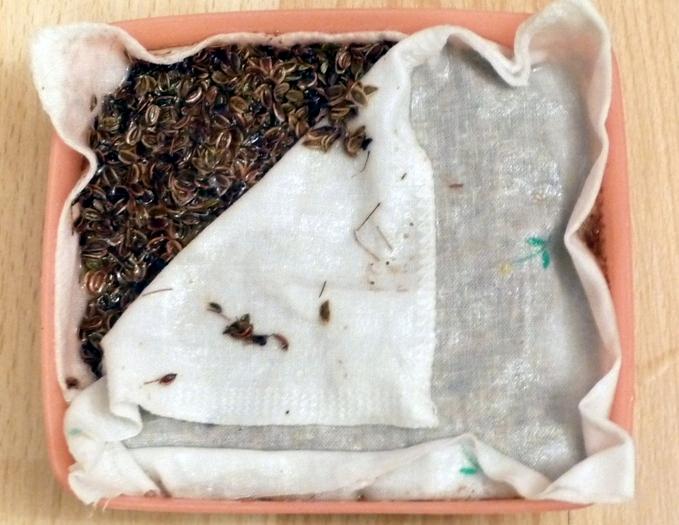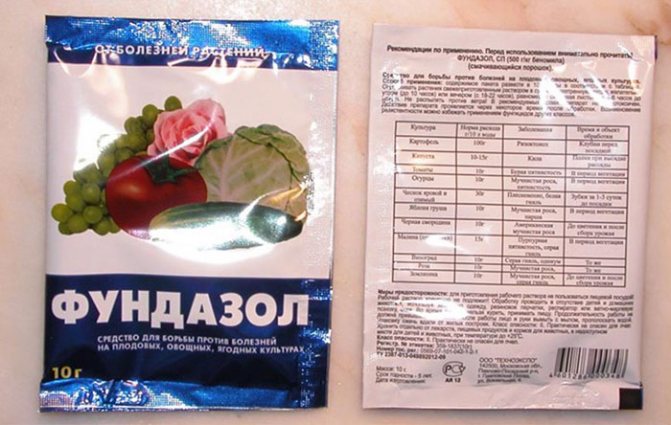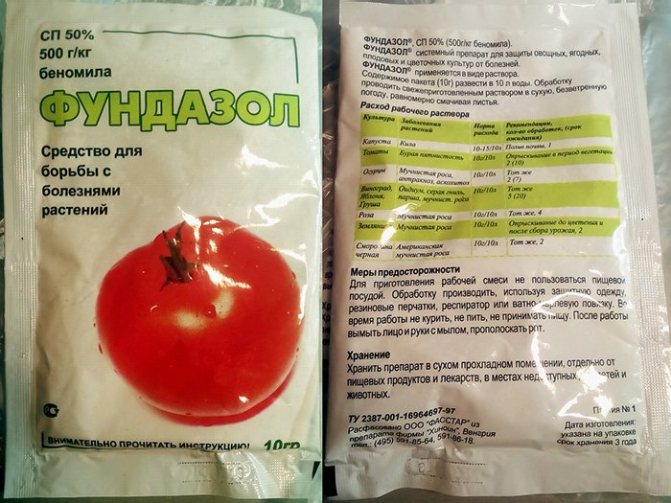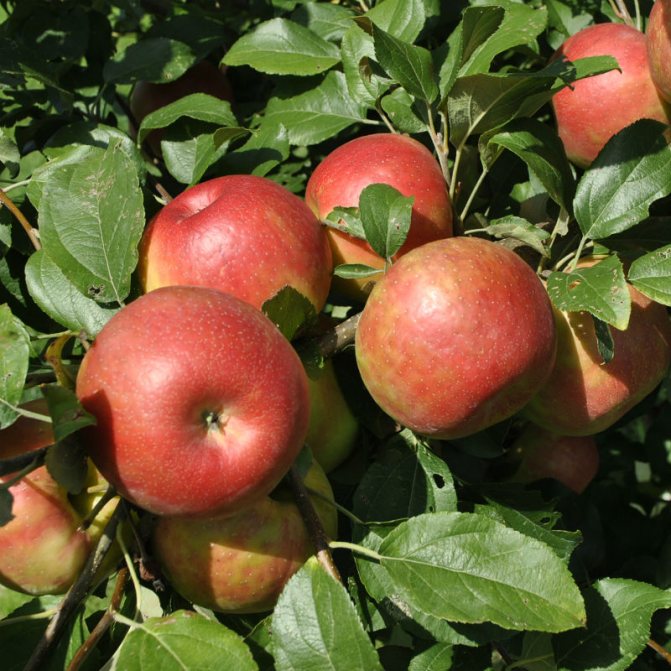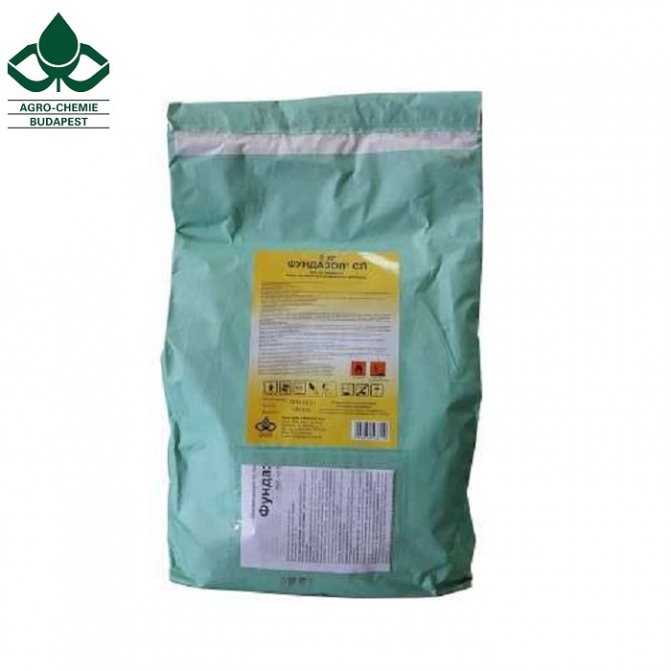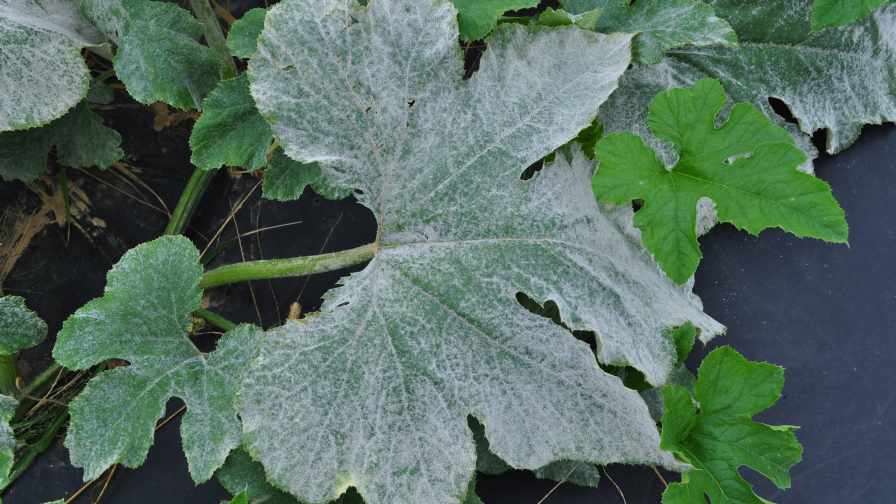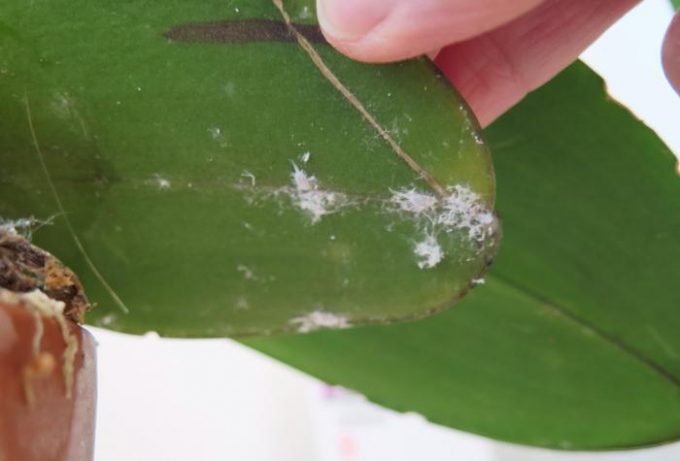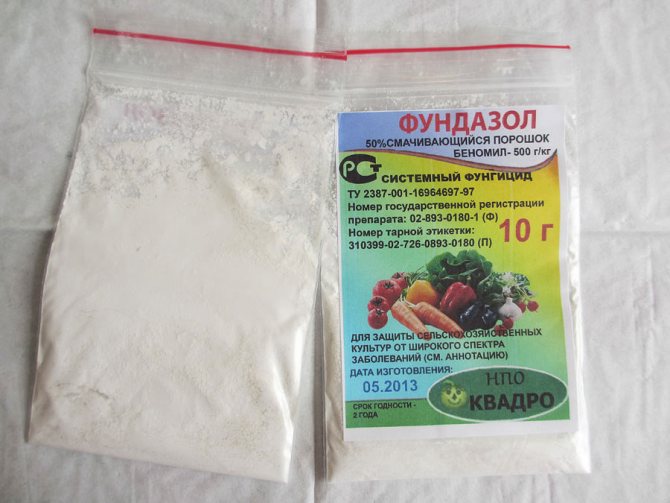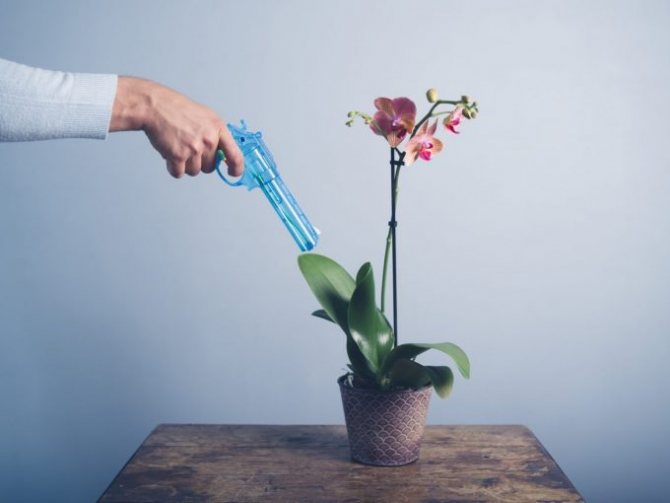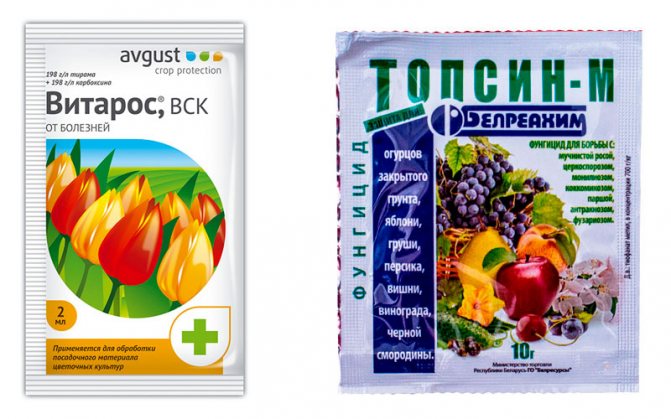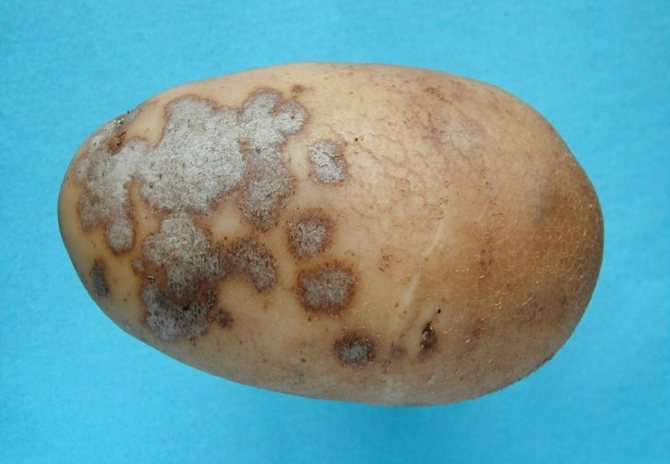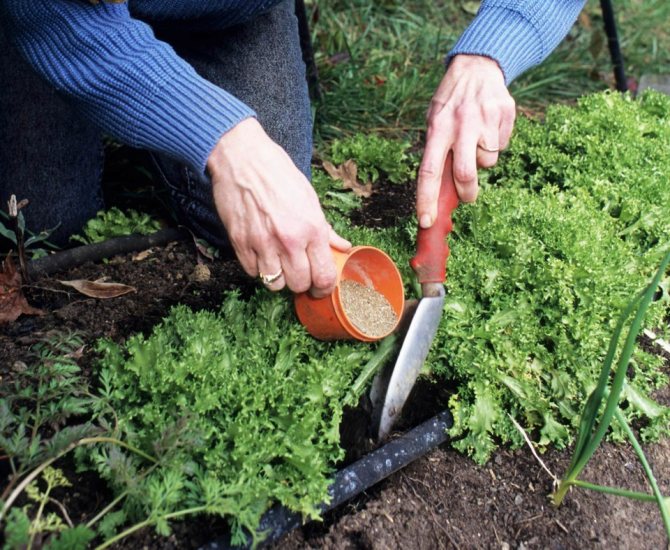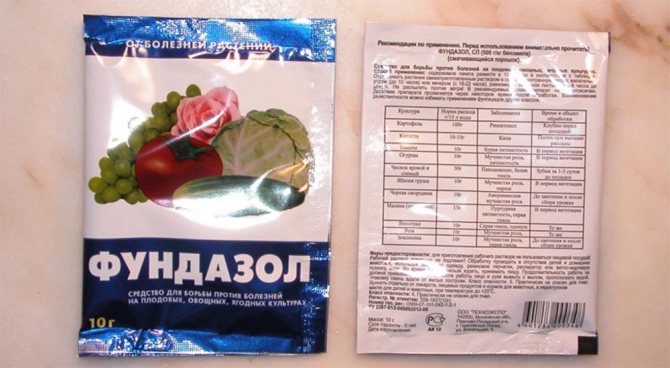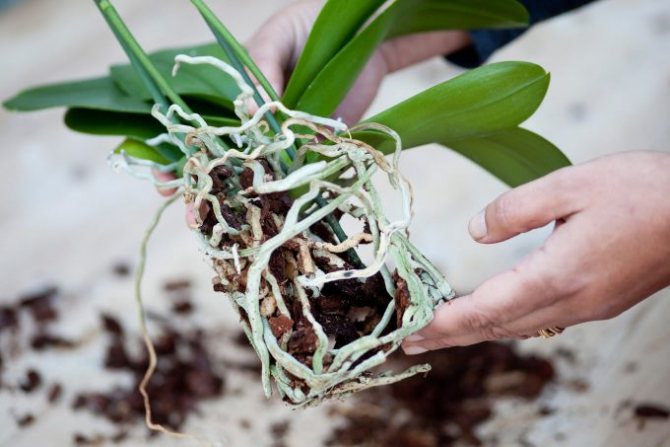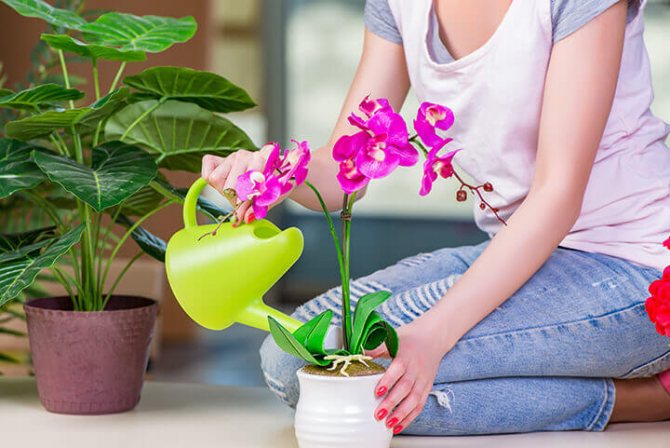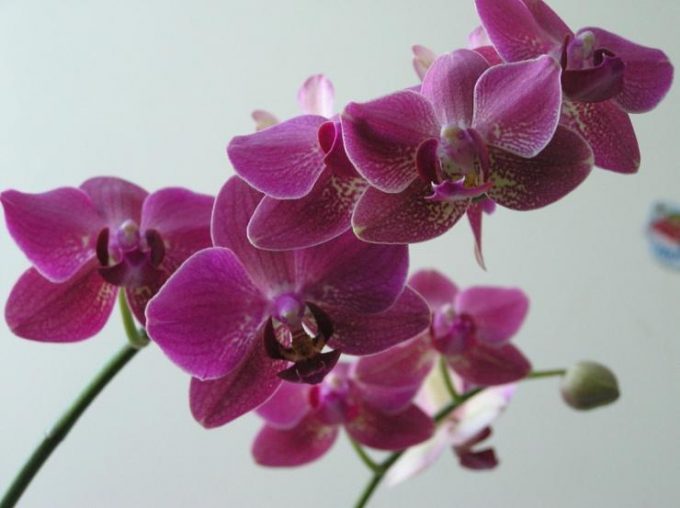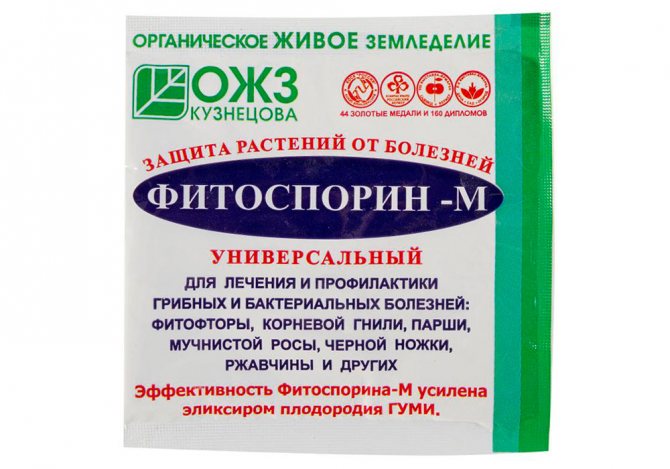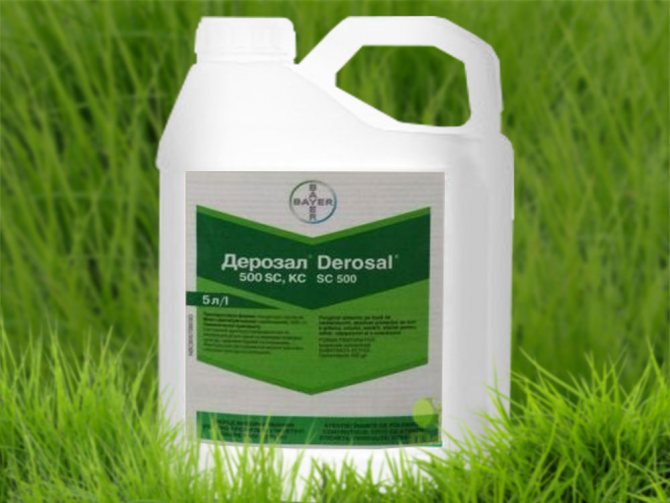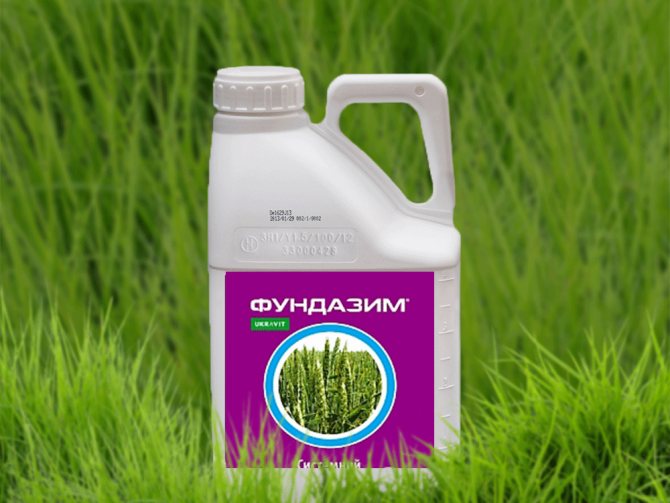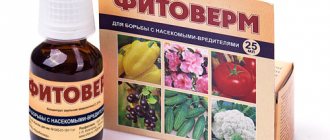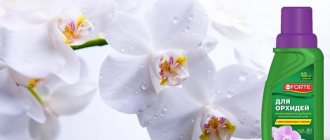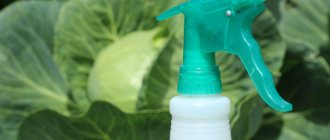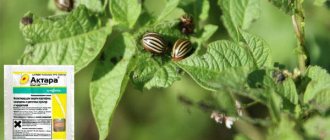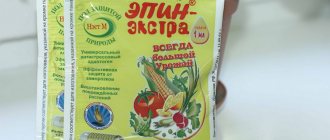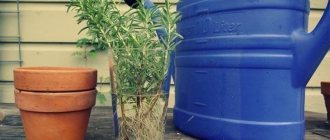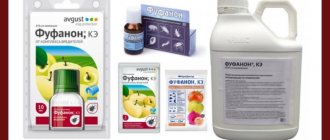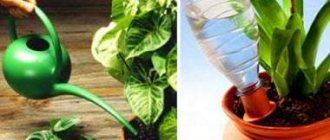To grow orchids at home, you need create something like the tropics... It is not always possible to please everyone.
Even experts and experienced florists may not name all diseases orchids. There are many of those. Fungal in orchids are more common.
Main reasons the appearance of diseases in orchids:
- Errors when watering plants;
- The soil is unsuitable;
- Transplant damage;
- Stagnant air;
- Temperature problems;
- Busting with fertilizers and dressings.
Below we will tell you in more detail how to use a foundation for orchids.
Foundation application
- Fundazole is effective against pathogens of fungal infections, such as:
common and snowy pine trees, moldy seeds, infectious lodging of seedlings of conifers, powdery mildew, gray rot - the causative agent of the genus Botrytis, spotted pathogens of the genus Septoria, Cladosponum, Colletotrichum, Marssomia, wilting and rot - causative agents of the genus Fusarium, Rhistoctonia, Sclerotinia, etc .;
- Powdery mildew - 3 treatments, Root and bulbous rot, gray rot - 2 treatments, Spots - 2-4 treatments, Seed pickling, seed mold - once, Fusarium - 2 treatments.
Topical questions about the drug "Fundazol"
Question number 1. Can Fundazol be combined with Fitosporin?
Can. Fundazol is an antifungal agent, and Fitosporin contains bacteria. Benomyl has no effect on them, like on all other bacteria. Therefore, treatments with "Fundazol" and "Fitosporin" can be carried out simultaneously. Another tactic is also possible: the first treatment should be done with "Fundazol", and the second, after 2 weeks - with "Fitosporin". This will help reduce pesticide pressure on orchids.
Question number 2. Is it true that pregnant women cannot work with Fundazol?
Rumors about the teratogenic effect of benomyl have been circulating for a long time - both in the Western press and in Russia. So far, no one has been able to prove this. Officially in Russia, benomyl preparations are classified as low-hazard to humans. But if there are any fears and doubts, during pregnancy it is better to remove Fundazol away and treat orchids with biofungicides.

Luxurious orchids are the pride of flower growers and it becomes especially offensive when they start to get sick. Today we will talk about all the intricacies of how to use Fundazol for orchids. It is a very effective drug, but at the same time it is quite powerful. If you get carried away with a fungicide, you can not only not help the plant, but completely destroy it completely. In addition, its use is not always effective, because the tool has its own specification.
Features of the foundation
The active substance of the basezol moves in the vascular system of plants only in the acropetal direction: from bottom to top along the xylem and does not move along the phloem. Those. the systemic effect is manifested only during watering and absorption by the roots, as well as during seed treatment. When spraying, fungicidal properties appear only at the site of absorption - it does not move from one leaf to another in fungicidal doses.
According to G.S. Gruzdeva (Chemical Protection of Plants, 1987), foundationazol is not effective against bacteria, at the same time, the Regulations for the Use of Pesticides in Agriculture of the Russian Federation indicate that foundationazol can be used against bacteriosis on vegetables, legumes and cereals. Who is right?
Fundazol gives rise to a lot of controversy among flower growers and especially those involved in growing indoor plants. Fundazol is especially popular among lovers of orchids and bulbs, due to its high efficiency against fungi.However, some consider the drug too toxic and inappropriate for household use. Rumor has it that the Fundazol sold in the store is a fake and a fake, that it has not been produced for a long time.
At the moment, Fundazol is included in the list of pesticides published in the ‘State catalog of pesticides and agrochemicals permitted for use in the Russian Federation’ as of July 04, 2019. The registration of the foundation ended on 12.2014. At the time of this writing (April 2019), foundazol is indeed sold in stores from old purchases, but the Ministry of Agriculture of the Russian Federation has not released a new catalog of approved pesticides. So the further fate of this drug is still unclear.
But it should be noted that, like any other pesticide, foundationol has its own limitations (frequency of treatments) and requires the implementation of traditional safety measures. With the systematic use of the same fungicide, including basezol (benomil), the resistance of fungal spores can increase 3–12 times. Therefore, if the drug did not help you, you should not consider it a fake.
And besides, the foundation is not effective against rust fungi, downy mildew and fungi of the genera Peronospora (peronosporosis), Prytophtora (late blight), Pthium (soft rot, black leg) - these phytoparasites have genetic cross-resistance. It should be noted that, according to the personal opinion of forestry specialists, Fundazol is no longer so effective in combating diseases of conifers, which are like a scourge for foresters.
Fundazole is a systemic fungicide. Description, purpose and composition of the drug
Mushroom killers are called plant protection products... If you translate the word fungicide. Life does not stand still. Pathogenic organisms adapt to many drugs. They develop resistance to their damaging components.
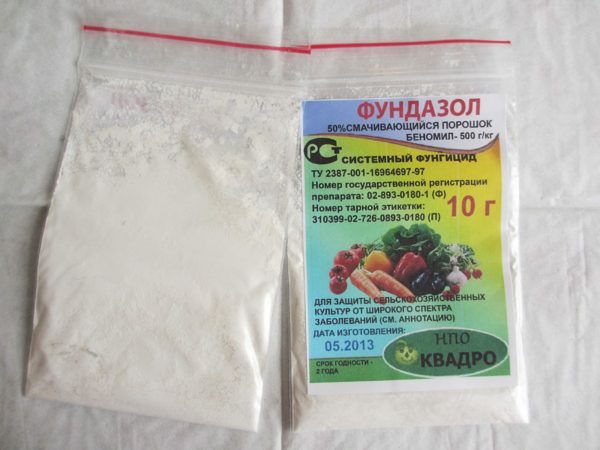

Fundazole protects the orchid from various diseases.
Experts come up with new ones, improve those already tested in practice.
Combined means are created. Including generating plant immunity to pathogens... It is not so easy to understand them even for experienced flower growers. Not to mention the newbies. After all, the patient is also serious. And dear. Orchid!
Classification of fungicides
By composition and origin:
- Inorganic chemical: Copper-containing;
- Sulfur-containing;
- Compounds of iron, mercury, zinc, borax and others.
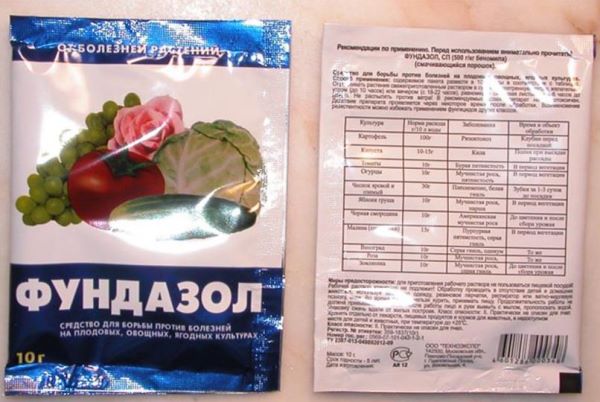

By purpose of use:
- Preventive;
- Immunizing;
- Medicinal.
By the principle of action:
- Systemic drugs... They penetrate into the plant system and circulate with juices;
- Contact... They both play the role of a barrier from pathogens. Or they directly act on the lesions.
The types of these drugs are different.:
- Simple;
- Combined with other fungicides, insecticides, fertilizers and retardants.
For indoor plants fungicides are used for immunization... More often when signs of disease or treatment of already affected plants appear.
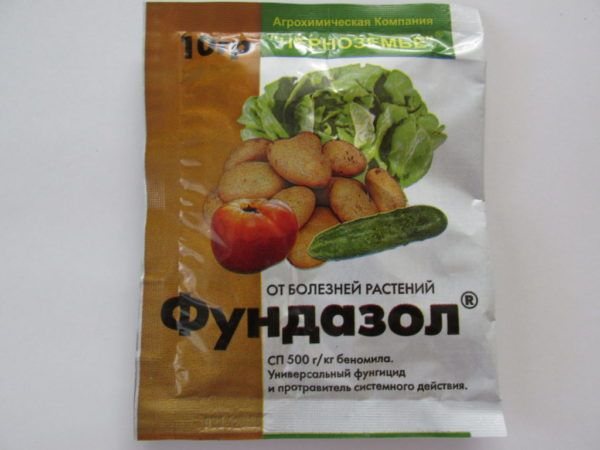

Fundazole first appeared in the United States.
Fundazol - one of the most famous fungicides:
- It was developed in the USA over 30 years ago. For processing planting material in seed plants;
- But in our time it is still used by flower growers. for disease preventionand for their treatment of plants: For dressing seeds and tubers before planting;
- For watering contaminated soil;
- For spraying plants during vegetation.
- Benleit;
- Pesticide, fungicide;
- Suppresses the ability of fungal spores to reproduce;
Foundation consumption rates
Dressing before planting tuberous (potatoes and other vegetables) by spraying. To prepare a solution, 10 g of foundation is dissolved in 0.5 l of water - this volume is enough for 10 seed tubers.
Etching of gladioli and amaryllis bulbs - by immersing the bulbs for 3 hours in a solution: 10 g per 2 l of water, garlic - for a day in a solution: 10 g per 0.5 l of water.
Instructions for using the foundation for the treatment of powdery mildew and other diseases on indoor and garden plants: spraying with a 0.1% working solution during the growing season. 10 g of foundation is diluted in 10 liters of water, while 1.5 liters of solution is consumed per 10 sq. M. Spraying before flowering and after harvesting in horticultural farms, or at the first sign of illness on indoor flowers.
Fundazol toxicity
Fundazol (benomyl) has low toxicity for bees and birds. Toxic to fish. Refers to highly toxic compounds for humans and warm-blooded animals for cutaneous, inhalation and oral toxicity. Prolonged contact causes dermatitis.
Security measures. When working with the drug, it is imperative to wear a respirator and gloves. It is advisable to dilute the working solution not in the apartment, but on the street. Avoid contact with eyes and skin. It is unacceptable to eat, drink and smoke. Wash hands and face thoroughly after handling.
First aid in case of poisoning: if the drug gets on the skin, wash off with plenty of water; in case of contact with eyes, rinse abundantly with running water; if it enters the digestive tract, drink 3-4 glasses of water, induce vomiting, take several tablets of activated carbon, seek urgent medical attention.
Read also Catnip to grow at home
Conclusions on the feasibility of using the foundation
When our flowers, especially our favorite, rare varieties, obtained after a long wait from other parts of our country, or from abroad, fall ill, we are ready to pour and spray them with anything, just to save them. We think a little about the consequences, but in vain. It is worth weighing the pros and cons. If you are not a future mother, you do not have children in the house and no less valuable than plants, pets, patients with asthma or immune diseases of family members, then you can try to save plants dying from an unknown disease. It is impossible to pinpoint a fungal or bacterial infection on your flowers at home. The data on foundazol are contradictory, perhaps, its effectiveness against bacteria is too negligible, and the resistance of pathogens of fungal diseases, on the contrary, is high, which means that the whole enterprise can be held like a lottery.
For the sake of completeness, it should be noted that pesticides are divided into hazard classes for a reason, the 2nd hazard class of the foundation means that it causes allergic reactions, is a probable carcinogen for humans and a strong teratogen (fetal anamaly) for animals, and has reproductive toxicity. At the same time, the basezol is slowly destroyed in the soil, the half-life of metabolites is from 3 to 6 months.
Indoors and indoors, indoor plants are not 100% protected from pests and diseases. Contrary to misconception, indoor plants are susceptible to disease and pest infestation. If a problem arises, it must be dealt with. It is worth remembering that the best treatment is prevention. For prophylactic purposes, drugs are used, including Fundazol.
You can buy it in specialized flower shops and on the Internet. Finding Fundazol on the shelves is more and more difficult, so more often you have to search through the Internet. Recently, many authorities and farms have banned the use of Fundazol, but this is not legally confirmed.
The active substance of the drug "Fundazol"
A substance belonging to the chemical class of benzylamidozols is produced under the trade name "Fundazol". It is called benomyl and has strong fungicidal properties. For the first time, the scandalous American corporation "Du Pont" brought it to the market of agrochemicals in the middle of the 20th century. Since then, controversy has not subsided around Fundazol and its active ingredient.
Benomil is a systemic eradication fungicide. This means that it has the following properties:
- It does not protect a healthy plant from possible infection, but kills an already developing fungus at any, even advanced, stage of the disease.
- It has the ability to spread through the tissues and organs of the plant and act on the fungus, regardless of its location.
Once in plant cells, the active ingredient "Fundazola" undergoes a series of transformations and turns into a metabolite of carbendazim. It is he who does all the basic medical work.
Fundazol's problem is the habituation of microorganisms to benomyl. This substance has been used for so long that resistant strains have emerged among the pathogens that do not react at all to the drug. Therefore, the treatment with "Fundazol" is not always effective.
Important! On sale you can find analogues of "Fundazol" under other names - "Benorad" or "Benlat". If the fungus does not react to Fundazol, you should not try to treat the orchid with drugs that contain the same active ingredient.
Description of the tool
Fundazole is a one-component type preparation based on a benomyl fungicide, used to protect against phytopathogenic fungi. Fundazole is a systemic fungicide that deeply affects plant tissues, penetrates through the ground part and the root. The drug has a pronounced therapeutic effect, protects fruit trees, nightshade crops, as well as orchids, roses and other flower beds. It is a medium-resistant substance, when it gets into the soil it is stored for up to 2 years, does not emit toxic fungicide vapors.
Fundazole application. Fundazol is a broad-spectrum drug. The drug is used as a therapeutic and prophylactic in the treatment of diseases of rhizomes, leaves, stems, seeds. Fundazol is great for 40 plant species.
Benomyl fungicide is a white powder with a dry structure with a pronounced sour odor. The powder does not dissolve in water, does not have volatility properties.
Properties of the drug
Due to some features, Fundazol can be used in various climatic zones: subtropics, central Russia. And also it can be applied at any time of the year.
The main active ingredient remains active in various temperature ranges. It is more correct to use it during soil cultivation or directly process plants. This can be done at the very beginning of spring and until the end of autumn. This drug is not toxic, in other words, depressing properties for soil and plants are not observed.
Subject to the correct dosage, the active components of Fundazol can act on any part of the plant, be it the stem, seeds or even leaf axils. It is best to treat the soil when applying the solution. In this case, the drug enters the plant through the roots, and the goal is achieved more efficiently.
The active ingredient of this drug is benomyl, it is he who has the most useful medicinal properties.The main properties of the drug are that the active substance can suppress the action of some fungi that infest the plant. In other words, adult fungi, as well as fungal spores that have come under the influence of an active substance, lose the ability to divide the nucleus.
The acaricidal properties of dynamil suppress the activity of some larvae, as well as adults of spider mites and other insects. The insecticidal properties of this drug are manifested in the complete destruction of the leaf beetle. The substance blocks the emergence of an adult from small larvae. Nematocides are manifested in the ability to destroy annelids that parasitize plants.
Fundazol has proven to be excellent in getting rid of plants from fungal diseases. For each of the cases, there is a certain dosage and treatment methods.
Fundazole can be applied to plants that grow in the room. In particular, it is excellent for treating most diseases of the home orchid. If the leaves are lying, the orchid flowers have become soft and have lost their elasticity, this may indicate the presence of a fungal infection. In this case, Fundazol for orchids will help.
The affected and discolored leaves are removed, and the cut sites are treated with a Fundazole solution. If the fungal infection has affected the plants too much, it can be placed in a transparent pot. Be sure to add polystyrene to dry soil and pour Fundazol over the roots of the plant. Oxygen must be provided in the pot. No watering required.
For tuberous plants and shrubs, it is very important to follow the instructions and dosage. A properly prepared solution will not harm plants and fruits.
- Strawberries, currants, gooseberries, as well as other berries that suffer from erysipelas or powdery mildew must be processed three times a season before flowering.
- Greenhouse cucumbers and tomatoes, as well as those planted in the ground, should be treated three times when symptoms appear.
- Killa-sick cabbage is treated only twice. The option of pouring the solution into the hole when planting is excellent.
- Potatoes suffering from the same diseases, and sometimes for prevention purposes, can be processed even before planting, based on the calculation of 12 g of powder per half liter of water. This amount of solution is enough for 10-15 potato holes.
- Bulbs of gladioli and tulips, as well as garlic, can be soaked in solution for a day immediately before planting in the ground.
Composition, properties
According to the instructions for use, "Fundazol" is a therapeutic and prophylactic agent intended for most plant species. The drug perfectly eliminates damage to roots, stems, leaves, seeds, and is often used for prophylaxis to protect plants from attacks of parasites and all kinds of diseases.
The main active ingredient in the composition is benomyl. Its main medicinal properties include:
- Ability to destroy microscopic worms that inhibit plant development.
- Ability to suppress leaf beetle larvae.
- Suppression and decrease in the activity of adults and larvae of spider mites.
- Suppression of the ability to reproduce in fungal spores.
Instructions for use
If you need to use a remedy to get rid of fungal diseases, it is important to follow the instructions. Depending on what the plant is sick with, the dosage will be adjusted. Approximate calculation of 20-25 g of powder per 1 liter of water.When processing this drug, the soil is watered or the leaves and stems are sprayed. The option of soaking the seeds before planting is possible.
Read also Quince Jam recipe with photo
One treatment course includes 4-6 sprays or waterings. To carry out the course of treatment of the plant with Fundazol should be no more than 2-3 times a season.
The ambient temperature plays an important role. The higher the temperature, the better the effect of Fundazol will be.
The effect of using Fundazol
The positive effect of using the drug can be observed within a week. After that, additional processing can be carried out for the purpose of prevention. Fundazole can be combined with other drugs, however, some features of the drug must be taken into account. For example, it is compatible with many pesticides, fertilizers and formulations that regulate plant growth. The active substances of Fundazole can retain their function when mixed with various drugs that react neutral to various aqueous solvents.
Fundazole solution should never be mixed with alkaline and lime preparations. In this case, the active substances may lose some of their properties, or even completely neutralize the anti-fungal properties. The drug will precipitate. Mixing of this medicinal product with fertilizers from the dinfant and benzimidazole groups is not recommended.
Substitutes for the drug. Recently, the drug Fundazol is quite difficult to find, often it is not even in specialized stores. Gardeners ask the seller for fungicide analogs, which may also have antifungal properties. Among them there are drugs that also have an active effect on the fungus, they can replace Fundazol.
- Derosal. The drug has a fairly wide spectrum of action.
- Topsin - m. The active substance of this drug qualitatively fights rot, powdery mildew and a number of other diseases.
- Vitaros. One of the most effective analogues of Fundazole.
- Fitosporin or foundation. A mild drug that includes a complex against various bacteria.
There are folk remedies for combating plant diseases. The most common one is activated carbon, which is in any person's medicine cabinet; it may well be an analogue of Fundazol.
disadvantages
It should be noted that the drug also has some disadvantages, which are important to consider before use:
- With frequent treatment of plants, resistance develops. Re-processing is allowed no earlier than after two seasons.
- The drug is dangerous for fish and humans. In this regard, it becomes necessary to observe precautions when using Fundazol.
- The drug has a high degree of flammability, therefore it is prohibited to use and store it near sources of open fire.
Safety measures when working with the drug
The dangerous constituent of Fundazol is Benomil fungicide. This substance is toxic to humans and has a second hazard class. Therefore, when working with Fundazol, a number of safety measures must be observed.
- It is necessary to work with gloves, goggles and protective clothing.
- It is not recommended to eat, drink or smoke while working with the drug.
- At the end of the work, you must thoroughly wash your face and hands using laundry soap.
The preparation is not dangerous for bees, worms and domestic animals.
If, nevertheless, the drug gets on the skin, then this area must be washed with plenty of water using laundry soap. If the drug gets on the nasal or oral mucosa, rinse the area and induce vomiting. Be sure to see a doctor.
The use of this drug must necessarily be justified.If the plants suffer from rather serious diseases, and a number of other drugs do not help, then, of course, the use of Fundazole can be decisive. The gardener must be sure that he can properly process the plants and at the same time avoid negative consequences for himself and his loved ones.
Advantages and disadvantages. Differences from other drugs
For a long time, growers choose it because of the advantages and benefits:
- Versatility and a wide range of applications;
- Penetrates the plant quickly and immediately acts on disease or pests. Within 2-3 hours after treatment, the spread of the disease is inhibited. Pathogenic microflora is completely blocked during the day;
- Temperature independent... Protective properties are retained at high and low temperatures;
- After a short time (about 3 hours), rains are not dangerous for him;
- The toxicity level is not high;
- The bulbs treated before planting provide plant protection throughout the growing season.
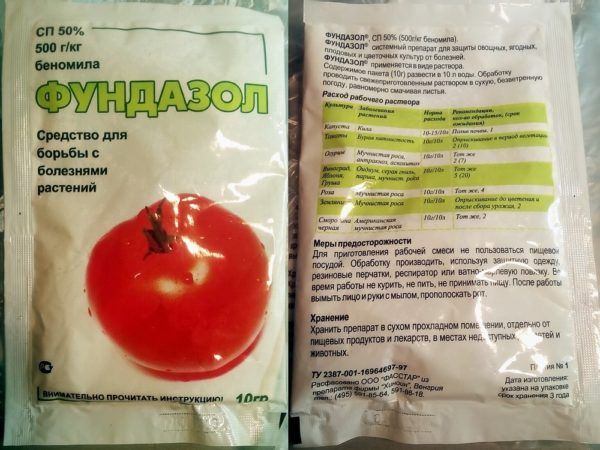

Fundazole has both advantages and disadvantages.
Consider and limitations of this fungicide:
- Do not store and use near open fire. The composition is highly flammable;
- Quite dangerous for humans. And domestic fish;
- It often cannot be used. Experts advise to apply on one area only after 3-4 years.
From the history of the foundation:
- Its use is being abandoned in America. The persistent resistance of pathogenic fungi to benzimidazoles (including the foundation itself) is the reason for this. And harmfulness. As it turned out, also for bees;
- In Russia, the registration period for this drug expired in 2019. But it is being produced. And they use it. As well as some other drugs (DNOC, Nitrafen).
Features of the drug
Fundazol is a non-volatile white substance. A characteristic feature of the tool is its geographical versatility. In other words, the drug can be used both in the northern regions of Russia and in the southern ones.
The main advantages of the fungicide are:
- Resistant to temperature changes. The tool will work with the same efficiency both in summer and in winter. This makes Fundazol a relatively versatile drug.
- Gentle attitude towards soil structures. Despite the fact that the fungicide belongs to the category of phytotoxic substances, it does not violate the quality characteristics of the soil. That is why the tool is actively used in soil cultivation. This type of processing is considered to be the most effective way of supplying the crop with the necessary substances.
- Extensive impact. The active ingredients have an effect on all parts of the plant.
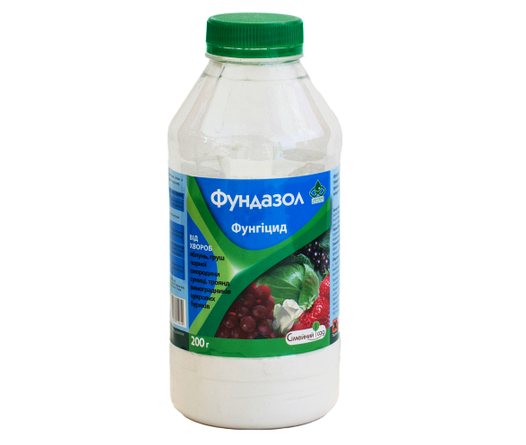

"Fundazol" has acaricidal, bactericidal, nematicidal and fungicidal properties
Forms of issue
Fundazol is produced in the form of a white or milky powder. The preparation is packaged in small volumes - 10 or 20 g each. Such dosage is convenient to use, since the open package of the powder is not stored for long.
Compatibility with other products
The drug, as a rule, is well compatible with many dressings, fertilizers, growth stimulants. However, this does not at all preclude the need for a careful combination of substances. The main rules in the use of a fungicide in parallel with other agents are:
- Substances belonging to the benzomidazole group are incompatible with the fungicide.
- Means that are neutral in contact with water can be combined with Fundazol.
- It is not recommended to use "Fundazol" with alkaline compounds at the same time. Alkali completely neutralizes the components of the fungicide and it loses its properties.
Operating principle
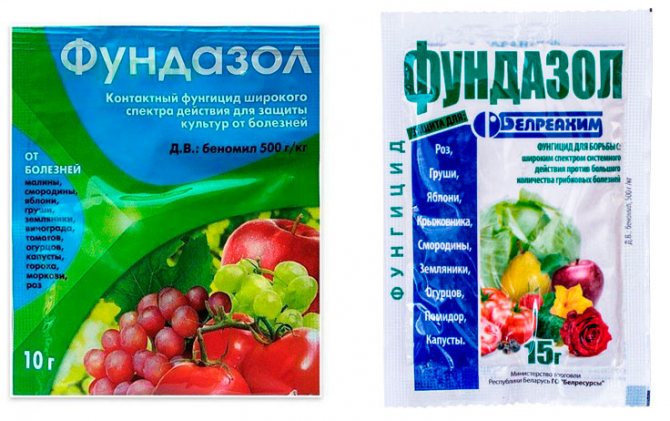

The active ingredient of Fundazol is benomil (500 grams per 1 kg of the drug). It is with its help that the process of division of cell nuclei in fungal microorganisms stops.Experts also draw attention to the fact that the drug has a slight pesticidal effect, suppressing the spread of spider mites (it does not allow the larvae to degenerate into an adult, but does not have any negative effect on eggs).
Benomil is a non-volatile substance, after treatment of plants or seeds, the healing effect lasts for 3 days, during the next 7 days, protection remains.
Application
The product has acaricidal, bactericidal, nematicidal and fungicidal properties. The drug is used for various types of crops, which include garden and indoor plants.
Main purpose
"Fundazol" has won the reputation of an effective drug, the mechanism of action of which is based on blocking the process of cell division of pathogenic fungi. In addition, the components have a detrimental effect on the cell itself, destroying it.


"Fundazol" is used to protect plants from a wide range of diseases
The active substances of "Fundazol" penetrate into the diseased plant through the root system and leaves. Individual chemical elements, transforming within the culture, become carbendazims, which intensely suppress the development of infection.
In addition, the product has a superficial effect. When the first symptoms of fungal infection appear, the gardener should spray the affected plant with a solution of Fundazole. This procedure will prevent the spread of pathogenic microorganisms.
Seed dressing
This event prevents fungal diseases, which are often carried by seeds. The process of processing planting material is characterized by the following activities:
- Bathing the seeds. 20 g of powder must be dissolved in 0.5 liters of water. After that, the seeds are dipped in the prepared solution for 20 minutes. After this time, the planting material is well dried.
- Spraying the bulbs. The spray solution is prepared from 20 g of the product and 2 liters of water. Irrigation is recommended to be carried out 3-4 hours before planting in the ground.
- Immersion. This method is applicable to almost all types of planting material, which is immersed in the prepared solution for a few seconds. After that, the material must immediately be planted in the soil.
Read also How to stew cabbage rolls in a saucepan recipe
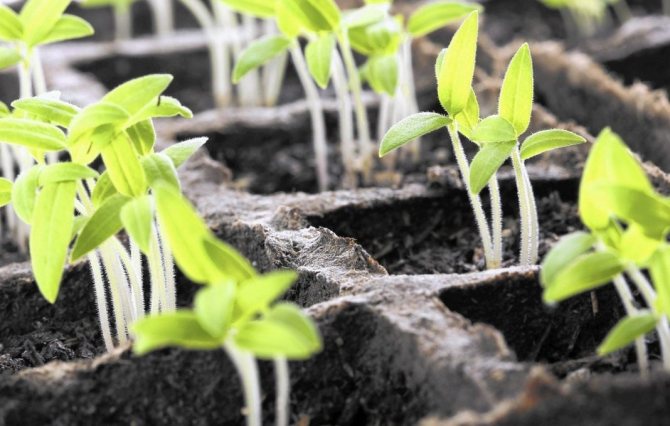

Seed dressing with a systemic fungicide guarantees a high germination rate
Processing on site
Applying "Fundazol" at their summer cottage, it is important to determine the permissible dose for each individual culture. Neglecting the dosage and consumption rate of the drug can lead to serious complications of horticultural crops.
For each culture, the dosage of the fungicide is determined individually:
- Tomatoes and cucumbers. For the treatment of powdery mildew and similar diseases, it is necessary to dilute 10 g of the product with 10 liters of water. The prepared solution should be sprayed on the plants twice a season. The first treatment is carried out during the growing season, and the second - 2 weeks before harvesting the fruits.
- Cabbage. Even if the cabbage plantings are completely healthy, it is recommended to carry out preventive treatments. The prepared solution is poured over the root zone. For 20 sq. m is spent, as a rule, 10 liters of liquid.
- Fruit trees. To prevent the development of fungal diseases, 5 treatments should be carried out. The solution is prepared in a 1: 1 ratio. For seedlings, 2.5 liters of liquid are needed, and for mature trees, about 5 liters.
- Fruit shrubs. The dosage of the fungicide is similar to that of fruit trees. Preventive treatment is recommended to be carried out twice - before flowering and after harvesting.
- Garden flowers. At the first sign of infection, the plant must be sprayed with a fungicide solution. If the symptoms persist after 2-3 days, the procedure is repeated.
It is important to remember that the duration of the drug on the plant is about a month.If, after this time, the culture has been attacked by a fungus, the treatment should be extended.


Table: norms and schemes for the use of the drug for plants in open ground
For indoor plants
The tool is actively used not only in gardening practice, but also for indoor plants. Fundazol works well with orchids. The first signs of infection are considered to be a kind of "limpness" of the leaves and stem. At this stage, it is very important to take action immediately, because the next stage in the development of the disease is blackening. The main protection procedure is considered to be watering the plant with a special solution. If the situation is running, it is recommended to replace the substrate with a new one and moisten it with a fungicidal composition.
It is impossible to spray directly the above-ground part, as chemical components can "burn" it.
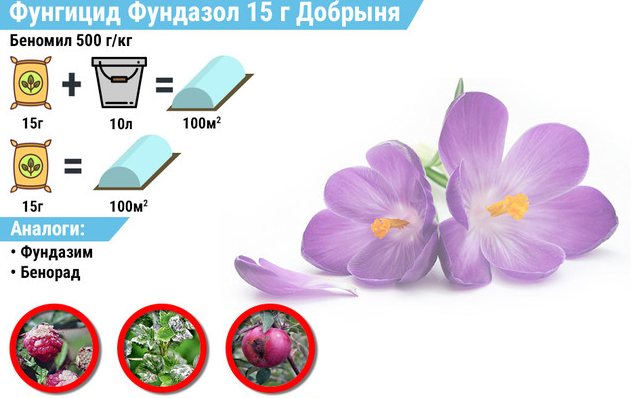

The scheme of using the drug for the treatment of indoor flowers and horticultural crops
Forms of release. Hazard Class
Powder white or cream color:
- Available in various packages. Small packages are convenient and practical for flower growers. 10, 20 grams per pack. After all, the prepared solution should not be stored for a long time;
- Fundazol belongs to the second class danger to mammals. This is a pretty high level. Reminds of Carbendazim and Fundazim. For birds and bees, its danger is classified as 3-4 class. But its effectiveness prevailed over danger. And it was used;
- The duration of the protective action is from 7 to 20 days;
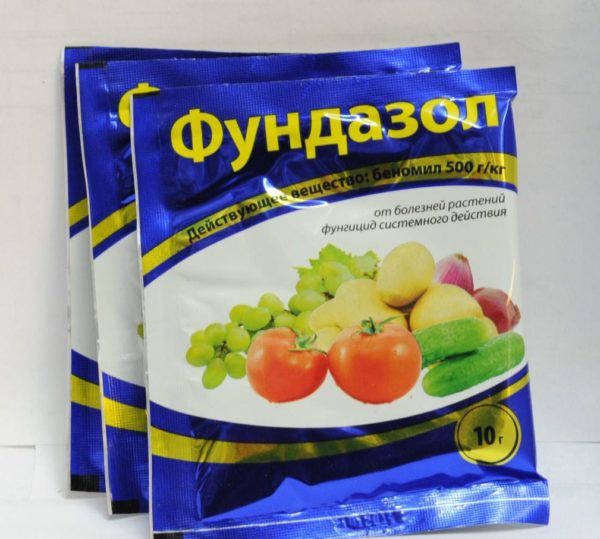

Fundazole is a white powder that must be dissolved before use. - What to replace: Vitaros;
- Topsin-M;
- Fitosporin;
- Fundazim;
- Derozil.
Instructions for use
The drug effectively fights the following diseases:
- anthracnose;
- gray rot;
- fusarium;
- late blight;
- phomosis;
- septoria;
- powdery mildew.
However, the effectiveness of the product has a negative side - the risk of severe consequences due to the chemical composition and the high degree of toxicity of the fungicide. That is why Fundazol is banned in the United States.
Precautions
When deciding to resort to the help of a strong fungicide, the florist must understand that a frivolous relationship with such substances is fraught with severe poisoning. Therefore, before starting processing, it is necessary to study the instructions in detail.
In addition, it is important to follow the precautions:
- Before preparing the solution, wear protective clothing that would cover all areas of the skin.
- To protect your eyes and respiratory tract from the harmful effects of toxins, you must use construction goggles and a respirator.
- It is recommended to carry out the processing outdoors. Indoor procedures will cause significant harm to health.
- The solution must be prepared in a specially designated container. In the future, it must be disposed of.
- During the procedure, it is strictly forbidden to eat, drink, smoke.
- After treatment, you must thoroughly wash your hands, and then your eyes and mouth.
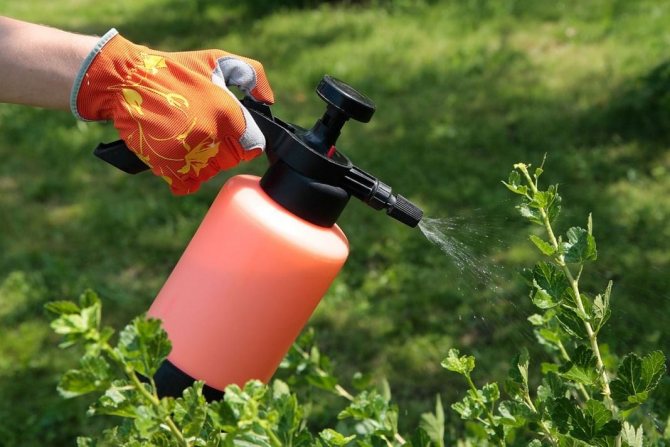

Remember to wear personal protective equipment when handling fungicide
Solution preparation and dosage
Dosage is a key issue in the process of combining the ingredients of the fungicidal solution. An incorrectly set dose of the drug, at best, will not produce the desired effect, at worst, it will cause the death of the plant and the poisoning of the gardener.
Requirements for water for dilution of the drug
To dilute the powder, you must use warm water infused for 12 hours. In such a liquid, the composition will dissolve as quickly and efficiently as possible.
Shelf life of the finished solution
The prepared solution retains its acaricidal, insecticidal, fungicidal properties for 2–4 hours. After that, it becomes completely useless.
Overdose
Some inexperienced gardeners use the fungicide at a higher dose than indicated in the instructions. This is quite dangerous, and not only for the plant, but also for the gardener himself. An overdose of the drug can destroy delicate crops such as roses, orchids. It is important to understand that the manufacturer has determined the dose in accordance with the level of toxicity of the drug, which means that it makes sense to listen to the instructions.
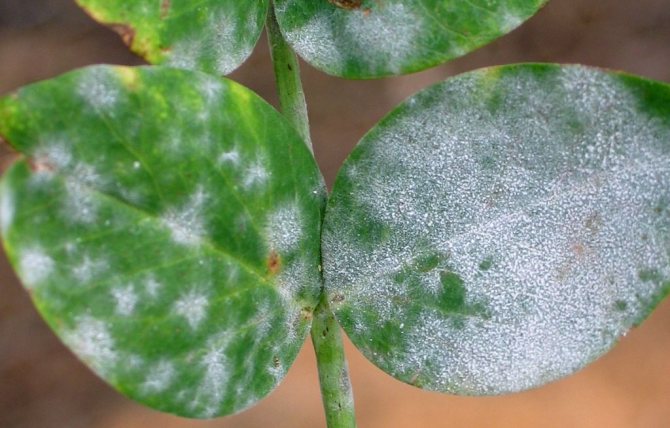

White bloom on plants after fungicide treatment is a sign of overdose
What diseases does it work against?
Fundazol is allowed to be used in the fight against the following diseases:
- Powdery mildew
- Bulb (as well as root) rot
- Spot (fungal origin)
- Fusarium
Expert opinion
Yulia Safronenko
A big fan of experimentation and personal gardening techniques
Ask a Question
It is also allowed to treat seeds to remove mold from them.
Analogues and substitutes
If for some reason the use of "Fundazol" is impossible, you should refer to analogues. The most similar in principle of action and composition are the following drugs:
Gardeners who are afraid to work with toxic agents use organic substitutes for the fungicide:
If the gardener is categorically against the use of chemicals, you can use alternative methods. One of the most popular options for combating fungal infections is watering the plant with a solution of activated carbon. It as a powerful sorbent absorbs all toxic substances, has an antiseptic effect on the soil.
Use for processing orchids
Fungicides, the drug is also able to positively affect plants that are grown at home. Fundazol is one of the most popular treatments for diseases in orchids. A fungal infection may be indicated by the softness of the stems and leaves of the plant.
At this stage of development of the lesion, the orchid should be treated with a fungicide as soon as possible. With a significant spread of the disease, wilting and blackening of infected stems and leaves begins. In this case, the affected parts of the plant should be removed, and the resulting sections should be treated with the Fundazol solution.
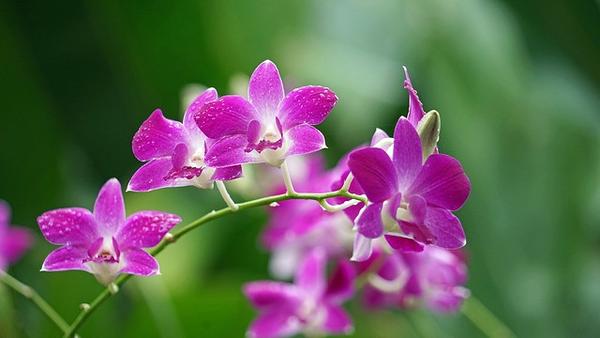

If the orchid is slightly affected by a fungal infection, the plant should be transplanted into a transparent container filled with a dry substrate mixed with foam. After transplanting, the plant must be watered with a medicinal solution.
In the case of orchids, spraying the plant itself is prohibited. To provide air exchange to the flower, small holes should be made in the container. Pruning of flowers and leaves of an orchid is not required, however, such a need may arise if the drug has a negative effect on infected parts of the plant.
Testimonials
Feedback from those gardeners who have used a strong fungicide in their practice will help form a more complete picture of the drug.
An excellent tool! It helped me a lot when my orchid was almost dead. The leaves began to turn black and wither, and the stem lost its former elasticity. I thought that the plant was completely dead, but no. Two treatments with "Fundazol" gave an instant effect.
Dmitry, Moscow
My father has known Fundazol for a long time. He keeps a vineyard that gets sick from time to time. The tool is very effective. One spraying is enough to completely kill the fungus. The only drawback is that the product is quite toxic, you need to carefully measure the doses. But seasoned gardeners have already, as they say, got their hands on.
Inna, Krasnodar
I am an avid florist, I have built a real greenhouse in my apartment. To prevent the plants from picking up the fungus, I regularly spray the topsoil with a fungicide solution. This is a preventive measure, so one package of powder is enough for a long time. Flowers are always in order, so Fundazol is completely satisfied.
Anna, Novorossiysk
"Fundazol" is a very effective drug - this is due to the presence of toxic substances in the composition. Reasonable handling of the fungicide will allow timely destruction of the pathogenic fungus without harming the plant and the grower.
Expert opinion on the prophylactic use of "Fundazol"
There is one more subtle point regarding the use of Fundazol, which is mentioned by some experts:
“In my practice, I have come across the fact that growers take very strong chemical agents to prevent infections. For some reason, Fundazol is especially popular, which is considered almost a panacea for all orchid ills. This is a serious mistake. For preventive purposes, you need to use simple and harmless biofungicides or, in extreme cases, non-systemic drugs. And "Fundazol" is an eradication agent. If you just pour it on orchids, in the future you can bring out resistant strains of fungi in your flower garden, which will be very difficult to get rid of. "
A. Davydovskaya, owner of the greenhouse
How to treat orchids with Fundazol (video)
In order to properly prepare a standard working solution on your own, you need to dilute a gram of the product in a small amount of clean water at room temperature, and then bring the solution to a volume of one liter. The resulting solution is used for spraying plants, as well as shedding soil. It is important to remember that when processing orchards or garden crops, the last spraying before harvest is carried out:
- cucumbers, squash and zucchini - in a week;
- tomatoes - in ten days;
- fruits and berries - in three weeks.
The maximum efficiency can be noted when carrying out medical or preventive measures at an air temperature of + 10 ° C or higher.


Fundazol can be used for disinfecting soil spillage
Solution preparation rules
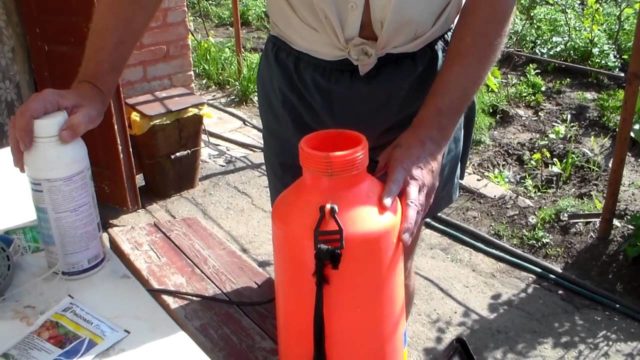

The dosage of the active substance directly depends on the culture to be processed. According to the instructions, an average dose, safe for use on all plants, can be considered - 1 g / 1 l of water.
Attention! Water for the preparation of the working composition should be taken purified or settled. The liquid must be poured into a plastic or glass container in small portions.
The solution is prepared by mixing the required amount of Fundazole with the required volume of water. In this case, it is important to thoroughly mix the product, preventing it from settling and sticking to the walls of the vessel. Watering or spraying must be done immediately after diluting the working composition.
Precautions
The drug, called foundationol, is a substance of the 2nd hazard class. That is, it is dangerous to humans and animals.
In the former, it can easily cause a terrible allergic reaction, and in the latter it is the cause of a violation of the reproductive system.
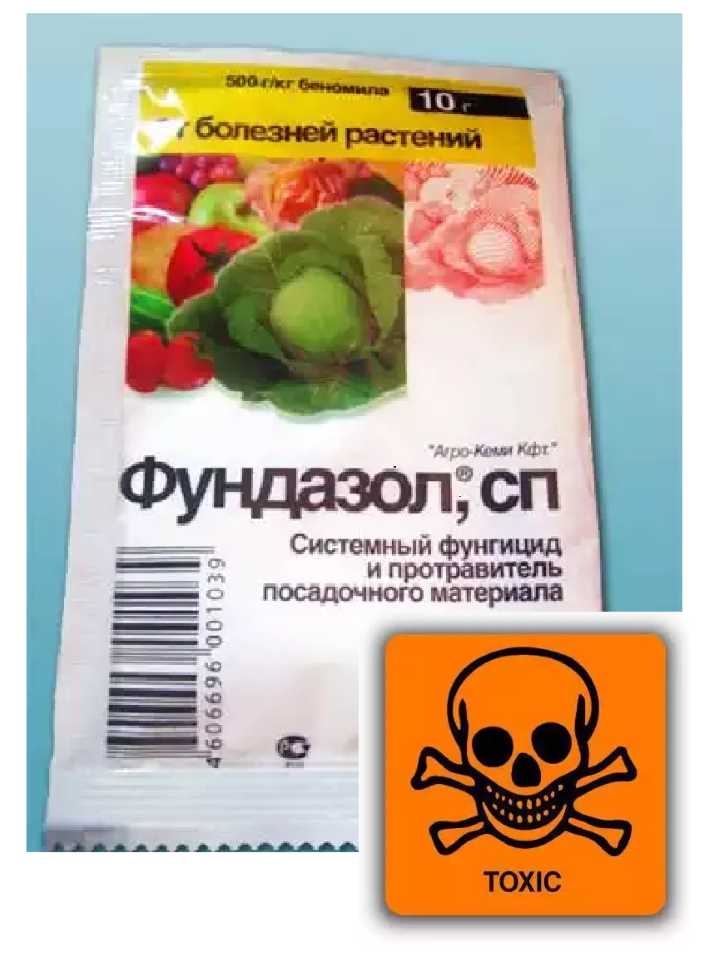

Fundazole decomposes slowly in soil, up to about six months. It is toxic to water, therefore, use near water bodies is strictly prohibited.
Naturally, it should not be used in residential premises. If another drug in the fight against diseases of indoor plants is not considered at all, you can process flowers outside the room. Fundazole should not be carried away by women in position.
Upon contact with the drug, the first thing to do is to close the skin, put on a respiratory mask and glasses. When spraying, do not eat, smoke or drink. When finished, wash your hands or wash your entire body.
Can I combine with other fertilizers
can be combined with other protective equipment. Most suitable for him:
- growth regulators;
- main group pesticides;
- growth stimulants.
Incompatibility is observed only with agents with pronounced alkaline reactions. You can check compatibility yourself.To do this, you need to mix the preparations and observe them, if no precipitate is formed, the solution does not become cloudy, does not change color, then this can be regarded as complete compatibility.
Receiving
Benomyl is obtained from cyanamide and methyl chloroformate via O-methyl-N-cyanocarbamate (route A) or from thiourea and dimethyl sulfate via S-methylisothiourea or its N-methoxycarbonyl derivative (route B). (image) Both carbamates are subjected to cyclocondensation with o-phenylenediamine. From a technical point of view, both paths (A and B) are convenient in that all stages are carried out without isolating intermediate substances (one-pot mode). The resulting N- (2-benzimidazolyl) aminocarboxylic acid methyl ester (carbendazim) is treated with butyl isocyanate to produce benomyl.
"Fundazol" as a seed dressing and planting material
Fundazol is produced in the form of a fine white powder that looks like starch. The official instruction suggests using a suspension prepared at the rate of 2-3 g of this powder per 10 liters of water for dressing seeds before sowing.
Pre-sowing disinfection of seeds is organized as follows:
If the farm has a plant for dressing tubers, it is more convenient to process the planting material with "Fundazol" in it.
- The seeds are tested for moisture. It should be no more than 16%. Practice shows that if it is higher, the field germination capacity of the material after dressing decreases.
- The seeds are driven through a winnower. Dusty grain with a large amount of debris increases the consumption of the suspension and reduces its effectiveness.
- Seeds and suspension are loaded into the dressing plant. The suspension in the spray chamber should be delivered in as thin a cloud as possible in order to more evenly envelop each seed.
The dressing can be carried out both on the eve of sowing, and in advance - 30 days before it. The effectiveness does not decrease from this.
In the prepared suspension, you can also "bathe" potato seed tubers, garlic bulbs and teeth, or uterine roots intended for planting on seeds.
Orchid diseases that are eliminated by fungicides
Plants from the genus epiphytes love moderate temperatures (+ 20-27 C), enough sun and good aeration of the roots. If the rules of cultivation are violated, the culture is attacked by fungi:
- Anthracnose. Brown spots with a clear border appear on the foliage, which turn into black bloom, pink mold. The causes of the disease are high air humidity (from 70%), cultivation errors.
- Gray rot. The pathogen settles on the dying plates of the orchid, at low temperatures it moves to healthy parts.
- Black rot. Root fungus occurs with excessive watering, abuse of nitrogenous fertilizing and from the bites of pests (scale insects, aphids, worms).
- Powdery mildew. Light bloom with a pink tint on fabrics spreads quickly. Develops under greenhouse conditions.
- Fusarium. A dangerous disease clogs the vessels of the plant, as a result, the culture withers, rots. The disease begins from the roots, then moves to the neck and foliage.
Fungi can covertly reside in orchids without showing signs. Under favorable conditions, spores wake up, actively multiply and destroy flowers. Owners bring in pathogens with new plants, contaminated substrate, or non-disinfected tools.
Diseases affect orchids in the fall, until the centralized heating was turned on, and in the spring, when they turned off. The lack of sunlight in winter leads to low absorption of water from the bark. A constantly wet substrate becomes the cause of the spread of diseases on plants.
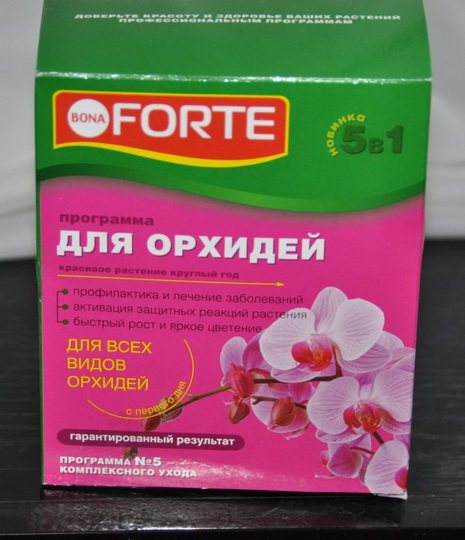

Physicochemical properties and characteristics of foundazol
So what is foundationol Is a broad-spectrum drug used to destroy infections and plant diseases caused by spores of pathogenic fungi.
The drug is used for preventive treatments of plants to prevent diseases, and seeds are also treated in this agent in order to prevent diseases of the future plant. The tool is used on many agricultural, ornamental crops, often used for indoor plants. Weather conditions do not particularly interfere with the action of the product; it is used in any climatic zone.
Fundazole is a systemic fungicide, its active ingredient benomyl penetrates into plant tissues, absorbed through roots and foliage, part of the drug remains on the surface, forming a white protective coating. The product is released in the form of a white powder with an unpleasant, but weakly pronounced odor. Fundazole is practically insoluble in either water or organic compounds.
Fundazole is produced by several manufacturers: KFT "Hungary, its representative office in Moscow" Agro-Kemi ", the Russian CJSC" August ".
Preparing seeds for planting
When preparing planting material and treatment with Fundazol, the consumption rate is an important factor. So the etching can be carried out both with a solution and with the powder itself.
To achieve the maximum effect, you must:
- Pour the garlic bulbs with a mixture of ten grams of the substance per half a liter of liquid;
- Pour the bulbs of gladioli with a solution at the rate of ten grams of powder per two liters of liquid and keep for three hours;
- Soak the seeds of tomatoes, cucumbers and cabbage with a similar solution or treat the substrate before direct planting.
Seed dressing can be carried out both in advance and immediately before planting. However, in both cases, it is worth considering the peculiarities of the dosage.
What fungicides are used for:
The appearance of an orchid signals a person about problems. The correct medicine will help to expel the disease. Viral diseases are difficult to cure, so the plant dies. Bacterial spots on the leaves are cut out to healthy tissue, the wounds are treated with a fungicide.
Root system diseases
Visually, the problem manifests itself on the plates that have lost their turgor. Blackened or rotten roots do not cope with the delivery of water, which negatively affects the appearance of the plant. The dead system is cut off, soaked for 30 minutes in the solution:
- copper-containing agent;
- Maxim the summer resident;
- Fundazole;
- Topsin.
The flower is left to dry at room temperature for 2 hours, then transplanted into fresh bark. As a prophylaxis, pots with the patient are treated with biopesticides (Glyokladin, Baktofit) once every 7 days. The pot is placed in a warm, sunny place, but shaded from bright ultraviolet radiation.
Appointment
For Fundazol, the instructions for use state that the fungicide is used to treat almost all garden and horticultural crops. The product can be sprayed or watered:
- flowers with the manifestation of spotting or powdery mildew;
- fruit trees with the manifestation of crop rot, scab, and also as protection against powdery mildew;
- berry bushes, strawberries and other crops suffering from berry rotting;
- tomatoes and cucumbers growing in open or closed ground;
- cabbage is watered at the root in case of keel disease;
- potatoes with Fundazole are treated for treatment and prevention;
- flower and garlic bulbs are soaked in Fundazole solution before planting.
For each culture, its own dosage and optimal processing method are calculated, which is reflected in the instructions for the fungicide.
Effectiveness and inefficiency
Due to its strong fairly fast action (its waiting period is 3-5 days) and a long-lasting protective effect (see below), the fungicide Fundazol is quite popular. However, its possibilities are not endless.
Preparations with benomyl, including Fundazol, are quite effective against harmful fungi of the genera Cladosponum, Colletotrichum, Cylindrocarpon, Fusarium, Marssomia, Phialiphora, Rhistoctonia, Sclerotinia, Septoria, Verticillium, etc.Outwardly, they manifest themselves in leaf spot, powdery mildew, gray and white dry rot, mildew of decorative and deciduous trees, see Fig.
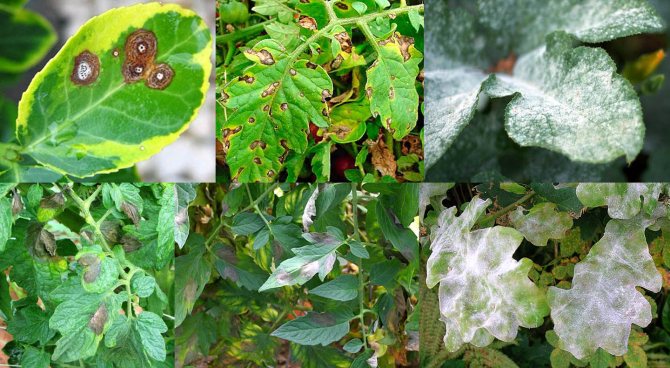

External signs of fungal diseases of plants, against which Fundazol helps
Fundazole is not very effective against the fungi Botrytis and others, which cause fungal diseases of conifers, on the left and in the center on the trail. fig. It is unacceptable to fight with fungal diseases affecting fruits (on the right in the figure) with Fundazol because of its harmfulness to warm-blooded animals and the ability to accumulate in fruits, see above. And finally, against fungi of the genera Peronospora, Phytophtora and Pythium (peronosoprosis, late blight, pythioses) Fundazole is useless: they are genetically resistant to it, and their hyphae penetrate deep into plant tissues and suck already fully formed plastic substances from the phloem. External signs of diseases, from which Fundazol is powerless - all rust rot, false (raw) powdery mildew, all soft and wet rot, for example. blackleg.


Signs of fungal diseases of plants, from which Fundazole is not very effective or its use is unacceptable
Note: the acaricidal (against mites) and nematicidal (from lower worms) properties of Fundazol have not been confirmed by objective studies. What was to be expected - sucking and gnawing pests of xylem with mineral salts do not need anything, they consume organic food from the phloem, which does not get benomyl. Reports from amateurs that spider mites or bulbous nematodes disappeared after treatment with Fundazol are either outright false or self-deception as a result of an accidental coincidence.
How to apply the fungicide by spraying and watering
The instructions for use indicate two methods of use: spraying with a product and watering. But you can also immerse the roots of the flower in Fundazol. A liquid must be prepared from the powder. To do this, it is worth measuring one gram of the substance and pouring it into a glass container. A liter of settled water is poured into it. After that, the powder is stirred until a homogeneous suspension. For root immersion, spraying and watering treatments, the mixture is made at the same concentration.
For spraying, the mixture must be poured into a spray bottle. After that, the flower is sprayed from below on the leaves and trunk. For watering the orchid, the suspension is poured into a watering can. The flower is placed in a pallet, and watering is carried out on the already wet soil. A glass of suspension is used to treat one plant. For immersion, the prepared liquid is poured into a bowl. The flower is pulled out of the pot, the roots are shaken off the soil. After that, the roots are immersed in a bowl and kept in liquid for 10 to 15 minutes. The flower roots are not washed additionally.
After the first treatment, a second procedure is needed. The second treatment is done even if the flower shows a positive trend after the first treatment. The third time, the fungicide treatment is no longer carried out. If after the first treatment there is no improvement, then the flower should not be re-treated with this preparation. Better to change the fungicide.
The active substance of the agent rises during treatment from the bottom up, and not from top to bottom. Treatment with the agent must be carried out below the area where the fungus is seen. Only solution is used for treatment. It is not recommended to use the drug in dry form (powder) during processing.
Popular: Correct spring planting of siderates in the greenhouse and in the ground
